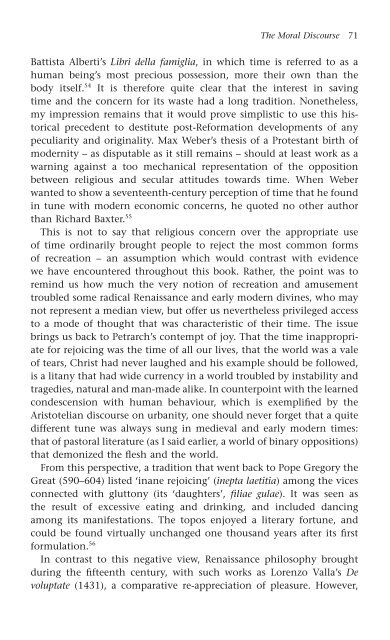Recreation in the Renaissance
Recreation in the Renaissance
Recreation in the Renaissance
- No tags were found...
Create successful ePaper yourself
Turn your PDF publications into a flip-book with our unique Google optimized e-Paper software.
The Moral Discourse 71<br />
Battista Alberti’s Libri della famiglia, <strong>in</strong> which time is referred to as a<br />
human be<strong>in</strong>g’s most precious possession, more <strong>the</strong>ir own than <strong>the</strong><br />
body itself. 54 It is <strong>the</strong>refore quite clear that <strong>the</strong> <strong>in</strong>terest <strong>in</strong> sav<strong>in</strong>g<br />
time and <strong>the</strong> concern for its waste had a long tradition. None<strong>the</strong>less,<br />
my impression rema<strong>in</strong>s that it would prove simplistic to use this historical<br />
precedent to destitute post-Reformation developments of any<br />
peculiarity and orig<strong>in</strong>ality. Max Weber’s <strong>the</strong>sis of a Protestant birth of<br />
modernity – as disputable as it still rema<strong>in</strong>s – should at least work as a<br />
warn<strong>in</strong>g aga<strong>in</strong>st a too mechanical representation of <strong>the</strong> opposition<br />
between religious and secular attitudes towards time. When Weber<br />
wanted to show a seventeenth-century perception of time that he found<br />
<strong>in</strong> tune with modern economic concerns, he quoted no o<strong>the</strong>r author<br />
than Richard Baxter. 55<br />
This is not to say that religious concern over <strong>the</strong> appropriate use<br />
of time ord<strong>in</strong>arily brought people to reject <strong>the</strong> most common forms<br />
of recreation – an assumption which would contrast with evidence<br />
we have encountered throughout this book. Ra<strong>the</strong>r, <strong>the</strong> po<strong>in</strong>t was to<br />
rem<strong>in</strong>d us how much <strong>the</strong> very notion of recreation and amusement<br />
troubled some radical <strong>Renaissance</strong> and early modern div<strong>in</strong>es, who may<br />
not represent a median view, but offer us never<strong>the</strong>less privileged access<br />
to a mode of thought that was characteristic of <strong>the</strong>ir time. The issue<br />
br<strong>in</strong>gs us back to Petrarch’s contempt of joy. That <strong>the</strong> time <strong>in</strong>appropriate<br />
for rejoic<strong>in</strong>g was <strong>the</strong> time of all our lives, that <strong>the</strong> world was a vale<br />
of tears, Christ had never laughed and his example should be followed,<br />
is a litany that had wide currency <strong>in</strong> a world troubled by <strong>in</strong>stability and<br />
tragedies, natural and man-made alike. In counterpo<strong>in</strong>t with <strong>the</strong> learned<br />
condescension with human behaviour, which is exemplified by <strong>the</strong><br />
Aristotelian discourse on urbanity, one should never forget that a quite<br />
different tune was always sung <strong>in</strong> medieval and early modern times:<br />
that of pastoral literature (as I said earlier, a world of b<strong>in</strong>ary oppositions)<br />
that demonized <strong>the</strong> flesh and <strong>the</strong> world.<br />
From this perspective, a tradition that went back to Pope Gregory <strong>the</strong><br />
Great (590–604) listed ‘<strong>in</strong>ane rejoic<strong>in</strong>g’ (<strong>in</strong>epta laetitia) among <strong>the</strong> vices<br />
connected with gluttony (its ‘daughters’, filiae gulae). It was seen as<br />
<strong>the</strong> result of excessive eat<strong>in</strong>g and dr<strong>in</strong>k<strong>in</strong>g, and <strong>in</strong>cluded danc<strong>in</strong>g<br />
among its manifestations. The topos enjoyed a literary fortune, and<br />
could be found virtually unchanged one thousand years after its first<br />
formulation. 56<br />
In contrast to this negative view, <strong>Renaissance</strong> philosophy brought<br />
dur<strong>in</strong>g <strong>the</strong> fifteenth century, with such works as Lorenzo Valla’s De<br />
voluptate (1431), a comparative re-appreciation of pleasure. However,










